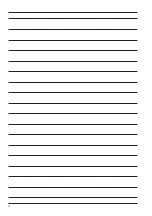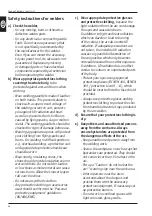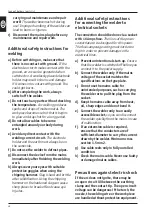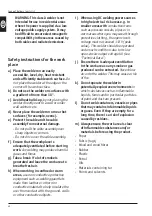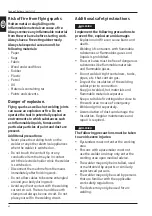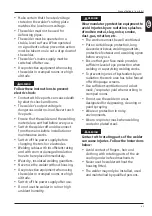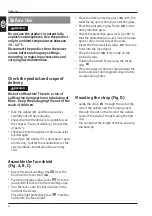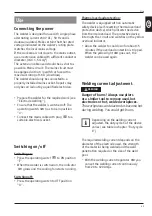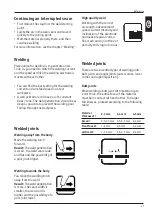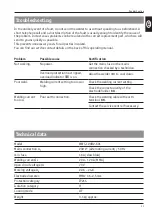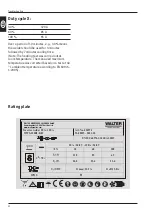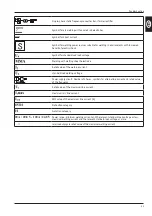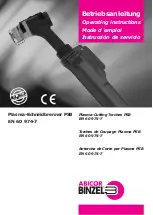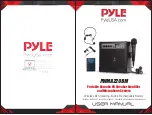
Scope of delivery / parts list
40
EN
Safety instructions for the work
place
a) Place the welder on an easily
accessible, level, dry, heat resistant
and sufficiently stable work surface.
Do
not place the welder at the edge or the
corner of the work surface.
b) Do not use the welder on surfaces with
a gradient of more than 10°.
c) Avoid heat build-up,
by not placing the
welder directly next to a wall or under
wall cabinets etc.
d) Never place the welder on or near hot
surfaces (for example, ovens).
e) Protect the cable and the cable
assembly from external damage.
-
Do not pull the cable assembly over
sharp objects or corners.
-
Do not drive over the cable assembly.
f) Ensure that the workplace is
adequately ventilated before starting
work.
Arc welding may produce harmful
gases and fumes.
g) Take a break if a lot of smoke is
generated and leave the work area to
breathe fresh air.
h) When working in confined or warm
areas,
use non conductive protective
equipment such as welding gauntlets
made from leather or other non
conductive material to help insulate the
user from contact with the ground, walls
or other conductive objects.
WARNING: This class A welder is not
intended for use in residential areas
where the power is supplied via a low-
voltage public supply system. It may
be difficult to ensure electromagnetic
compatibility in these areas caused by
both cables and radiated emissions.
i) When using DC welding power sources
in high electrical risk areas e.g. in
smaller areas with
conductive items
such as pressure vessels, pipes or in
warm areas where you may sweat through
protective clothing, the open circuit
voltage must not exceed 113 V (peak
value). This welder should be operated
under such conditions due to its low
open-circuit output voltage U0 (see
"Technical Data").
j) Ensure there is adequate ventilation
in the work area so any smoke or gas
produced can be extracted.
Never blow
air onto the welder. This may cause a risk
of fire.
k) Do not operate the welder in
potentially explosive environments
in
which substances such as inflammable
liquids, fumes and in particular particles
of paint and dust are present.
l) Do not weld containers, vessels or pipes
that may contains infalmmable liquids
or gases. Even if they are empty for a
long time, there is a risk of explosion
caused by residues.
m) Always ensure the work area is clear
of inflammable substances and/or
materials before using the product.
-
Paper
-
Fabric (rags)
-
Wood and wood fibres
-
Rubber
-
Plastic
-
Petrol
-
Oils
-
Materials containing tar
-
Paints and solvents.
Содержание WWS-120B2-K01
Страница 3: ...1 2 3 4 5 6 7 8...
Страница 4: ...9 10 11 12 13 14 15 16 17 18 19 20 21 22 23 24 25...
Страница 5: ...A C B 11 16 22 21 20 16 24 19 23 18 17 24 25 10 15 4 5 13 12 14 E F D...
Страница 32: ...32...
Страница 54: ...Exploded view 54 EN Exploded view 6 7 8 9 14 13 10 11 15 12 4 16 19 20 21 22 23 24 29 28 27 26 25 1 18 5 2 17...
Страница 80: ...Dessin clat 80 FR Dessin clat 6 7 8 9 14 13 10 11 15 12 4 16 19 20 21 22 23 24 29 28 27 26 25 1 18 5 2 17...
Страница 104: ...V kres d l 104 CZ V kres d l 6 7 8 9 14 13 10 11 15 12 4 16 19 20 21 22 23 24 29 28 27 26 25 1 18 5 2 17...
Страница 128: ...Razstavljena risba 128 SI Razstavljena risba 6 7 8 9 14 13 10 11 15 12 4 16 19 20 21 22 23 24 29 28 27 26 25 1 18 5 2 17...
Страница 131: ...131...







